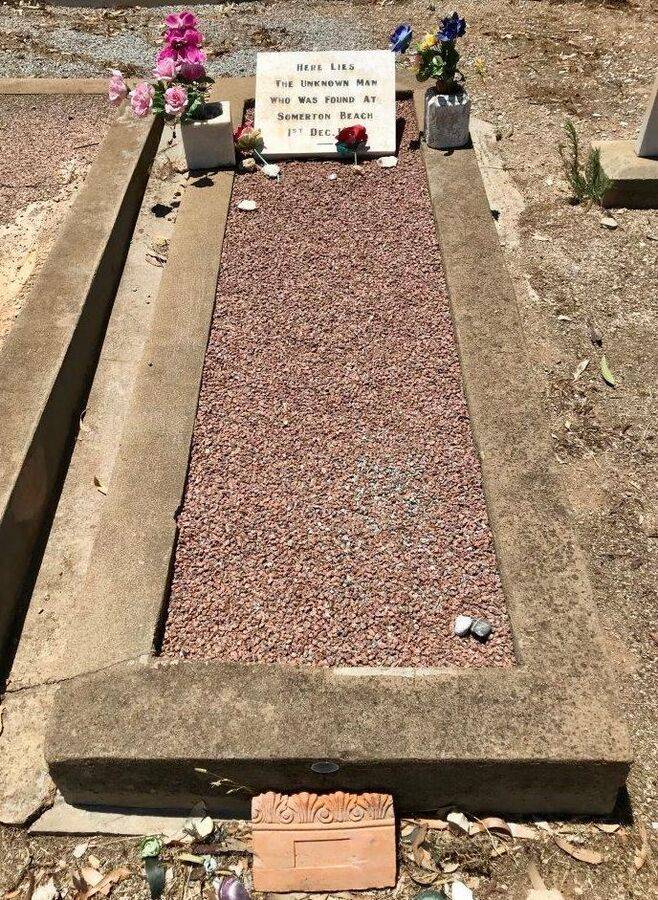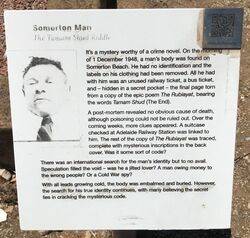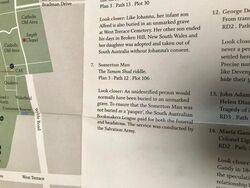
Somerton ManPrint Page 
The headstone over the gravesite and funeral were paid for by the Bookmakers League, in memory of the unknown Somerton Man.
The Tamám Shud case, also known as the Mystery of the Somerton Man, is an unsolved case of an unidentified man found dead in 1948 on the Somerton Park beach, south of Adelaide. The case is named after the Persian phrase tamám shud, meaning "ended" or "finished", which was printed on a scrap of paper found months later in the fob pocket of the man's trousers.
The scrap had been torn from the final page of a copy of Rubaiyat of Omar Khayyám, authored by 12th century poet Omar Khayyám. Tamám was misspelt as Tamán in many early reports, and this error has often been repeated, leading to confusion about the name in the media.
Following a public appeal by police, the book from which the page had been torn was located. On the inside back cover, detectives were able to read–through indentations left from previous handwriting - a local telephone number, another unidentified number, and text that resembled an encrypted message. The text has not been deciphered or interpreted in a way that satisfies authorities on the case.
The case has been considered, since the early stages of the police investigation, "one of Australia's most profound mysteries". There has been intense speculation ever since regarding the identity of the victim, the cause of his death, and the events leading up to it. Public interest in the case remains significant for several reasons: the death occurred at a time of heightened international tensions following the beginning of the Cold War; the apparent involvement of a secret code; the possible use of an undetectable poison; and the inability of authorities to identify the dead man.
In July 2022 Professor Derek Abbott from the University of Adelaide believes the man found on 1 December 1948, was Carl “Charles” Webb, a 43-year-old electrical engineer from Melbourne. Abbott’s research was undertaken with American genealogist Colleen Fitzpatrick. The pair analysed DNA evidence from hairs caught in a plaster cast made of the man’s face more than half a century ago by investigators. The South Australian Coroner will be asked to confirm the identification.
Location
| Address: | 161 West Terrace, West Terrace Cemetery, Plan 3, Path 12, Plot 106, Adelaide, 5000 |
|---|---|
| State: | SA |
| Area: | AUS |
| GPS Coordinates: | Lat: -34.935979 Long: 138.587092 Note: GPS Coordinates are approximate. |
Details
| Monument Type: | Grave |
|---|---|
| Monument Theme: | People |
| Sub-Theme: | Community |
| Link: | https://www.smithsonianmag.com/hist… |
Dedication
Here lies the Unknown Man who was found at Somerton Beach
1st Dec. 1948
Somerton Man
The Tamam Shud Riddle
It's a mystery worthy of a crime novel. On the morning of 1 December 1948, a man`s body was found on Somerton Beach. He had no identification and the labels on his clothing had been removed. All he had with him was an unused railway ticket, a bus ticket, and - hidden in a secret pocket - the final page torn from a copy of the epic poem The Rubiayat, bearing the words Tamam Shud (the end).
A post-mortem revealed no obvious cause of death, although poisoning could not be ruled out. Over the coming weeks, more clues appeared. A suitcase checked at Adelaide Railway Station was linked to him. The rest of the copy of The Rubiayat was traced, complete with mysterious inscriptions in the back cover. Was it some sort of code ?
There was an international search for the man`s identity but to no avail. Speculation filled the void - was he a jilted lover ? A man owning money to the wrong people ? Or a Cold War spy ?
With all leads growing cold, the body was embalmed and buried. However, the search for his true identity continues, with many believing the sercret lies in cracking the mysterious code.








